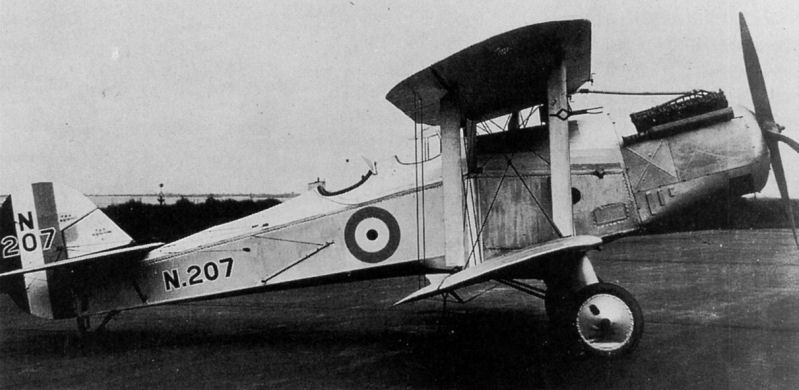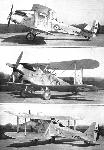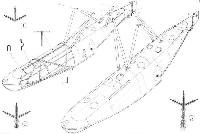
Описание
Страна : Великобритания
Год : 1926
Единственный экземпляр
Двухместный самолет повышенной подготовки летчиков палубного и аэродромного базирования
Blackburn TR.1 Sprat
С целью сокращения расходов в условиях мирового кризиса 1920-х годов Министерство авиации приняло решение заказывать многоцелевые самолеты. Следствием такого решения стала спецификация 5/24 к двухместному самолету со сменным колесным/поплавковым шасси, предназначенному для использования в ВВС в качестве учебного, а в морской авиации - как учебного палубного с колесным шасси и учебного гидросамолета с поплавковым шасси. На конкурс было предложено несколько проектов, из которых отобрали Blackburn TR.1 Sprat, Parnall Perch и Vickers Type 120 Vendace.
Sprat стал первым тренировочным самолетом фирмы "Blackburn" (TR - Trainer). Фактически он являлся увеличенным вариантом самолета Velos с измененной носовой частью фюзеляжа для улучшения обзора из кабины. Самолет имел смешанную конструкцию, но из дерева была изготовлена только хвостовая часть фюзеляжа. Обшивка выполнена из легкого сплава. По конфигурации Sprat являлся равнокрылым бипланом, крылья складывались вдоль фюзеляжа.
Единственный прототип выполнил первый полет 24 апреля 1926 года.
Sprat проиграл сравнительные испытания самолету Vendace, который и рекомендовали для запуска в серию, но и его производство наладить не удалось по экономическим причинам.
ТАКТИКО-ТЕХНИЧЕСКИЕ ХАРАКТЕРИСТИКИ
Blackburn TR.1 Sprat
Тип: двухместный самолет повышенной подготовки летчиков палубного и аэродромного базирования
Силовая установка: V-образный мотор Rolls-Royce Falcon III мощностью 275 л. с.
Характеристики: максимальная скорость на уровне моря 185 км/ч; скороподъемность 335 м/мин; практический потолок 5335 м
Масса: пустого 1050 кг; максимальная взлетная 1460 кг
Размеры: размах крыла 10,59 м; длина 8,92 м; высота 3,35 м; площадь крыльев 37,76 м!
Описание:
- Blackburn TR.1 Sprat
- Flight, May 1926
THE BLACKBURN "SPRAT"
Фотографии
-
Мировая Авиация 57
Регистрационный номер: N207 [6] Очередная конструкция майора Бампуса, TR.1 Sprat, была оснащена неубираемым трехопорным шасси с хвостовым костылем. Колеса основных опор могли меняться на дюралюминиевые поплавки.
Prototype of the Blackburn Sprat (N.207) shown here in land version. -
Flight 1926-05 / Flight
Регистрационный номер: N207 [6] THE BLACKBURN "SPRAT": This front view shows the divided undercarriage, for which a float chassis can be substituted.
-
Flight 1926-05 / Flight
Регистрационный номер: N207 [6] The Blackburn "Sprat" landing at Brough after a test flight.
-
Aeroplane Monthly 1982-05 / G.Todd - Rover's Return
Регистрационный номер: N207 [6] The Blackburn Sprat, on which the author worked, seen taking off from Brough in 1926. This deck landing aircraft was first flown on April 24, 1926 by P. W. S. Bulman.
The Blackburn "Sprat" (Rolls-Royce "Falcon") The "Sprat," designed and built by the Blackburn Aeroplane and Motor Company of Leeds, is a training machine of relatively low power, and a feature of it is that it can be used either as a land aeroplane or as a twin-float seaplane, the two undercarriages being interchangeable. A particularly good view from both cockpits is obtained, as they are placed aft of the trailing edge of the top plane, a feature of value in all machines, but particularly in a training type, especially as the "Sprat" is also to be used for training in the landing on the deck of a ship, where a very small divergence from the correct spot may easily spell disaster. -
Flight 1926-05 / Flight
Регистрационный номер: N207 [6] THE BLACKBURN "SPRAT," three views of which are shown, is a training machine convertible into a landplane or seaplane. The engine fitted as standard is a Rolls-Royce "Falcon" of 275 h.p.
-
Air Pictorial 1957-06 / ??? - The Blackburn Sprat /Little-known Aircraft/
Регистрационный номер: N207 [6] Prototype of the Blackburn Sprat (N.207) shown here in floatplane version. For conversion adjustable trestles were placed under the nose and rear of fuselage, and the aircraft raised clear of the ground allowing the change to be made quickly.
-
Flight 1926-05 / Flight
THE BLACKBURN "SPRAT": Some constructional details. The main sketch shows the two Duralumin floats, with their struts. The 12 inspection holes in each float have their covers riveted on. The transverse tubes through the floats serve to accommodate the beaching chassis, to which a jack action is given by levers (not shown) held in position by catches, of which that on the starboard float is shown. The float framework is also illustrated, with sections of certain main members. At 1, is shown the joint of the keelson to keel and planking near the bows, while 2 illustrates the same joint some distance aft of the step, and 3 the joint, with steel shoe on keel, immediately aft of the step. Note that water rudders are fitted in order to give good manoeuvrability on the water.
-
Flight 1926-05 / Flight
THE BLACKBURN "SPRAT": In order to accommodate pilots of different height, the foot bars are made adjustable, the means of adjustment being such that the cables are always maintained at an even tension. On the right a sketch showing a typical cowling clip with locking device.
-
Flight 1926-05 / Flight
Blackburn "Sprat" 270 hp. Rolls-Royce "Falcon" Engine
- Фотографии









